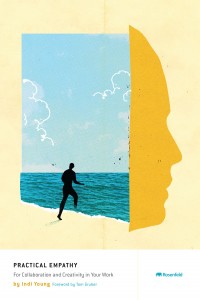
“Voice of the customer”. “Understand user needs”. “Get out of our silos”. “No more group-think”.
It’s no longer news that it’s a good idea to understand, respect, and design for other people’s perspectives. And there are plenty of books around on a plethora of specific techniques to help with that. (Disclosure: I’m writing one myself, on surveys).
Indi Young’s engaging little book “Practical Empathy: For Collaboration and Creativity in Your Work takes a different approach. Her focus on ’empathy’ gets away from the ability to share the feelings of others to focus on understanding those feelings in ways that help us to act on them.
The chapter that I found most immediately useful was Chapter 4, ‘A new way to listen’. She gets away from the language of ‘the interview’ – as she points out, a concept that may bring up uncomfortable resonances of job interviews, disciplinary interviews, and other stereotyped interactions. Instead, she proposes ‘Listening sessions’ – and explains exactly how to do them, in a way that’s clear, practical, and allows for flexibility.
That ‘practical’ note shines through the rest of the book – and definitely justifies its place in her title. You’ll find solid advice here for learning about others – customers, clients, colleagues – and then using that understanding in your own designs, in workplaces, and in developing an ’empathetic mindset’ for everyday life.

Early in the book, she’s included this ‘Frequently Asked Question’:
“How are you using the word “empathy?”
And her answer is:
“This book is not about the kind of empathy where you feel the same emotions as another person. It’s about understanding how another person thinks – what’s going on inside her head and heart. And most importantly, it’s about acknowledging her reasoning and emotions as valid, even if they differ from your own understanding. This acknowledgment has all sorts of practical applications, especially in your work. This book explores using empathy in your work, both in the way you make things and the way you interact with people.”
I think that sums up the book very well indeed.
(This review was originally published on Amazon.co.uk)
